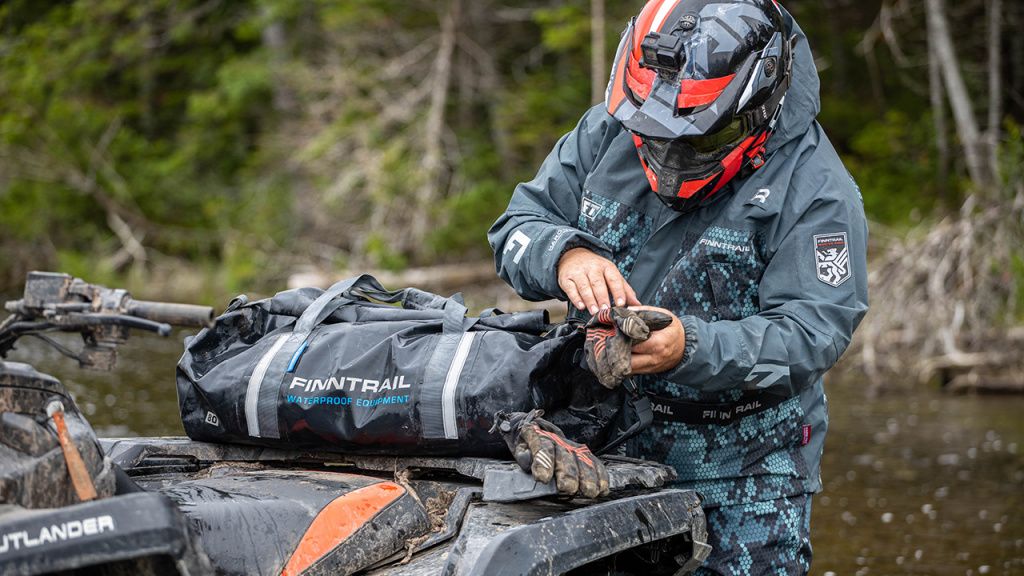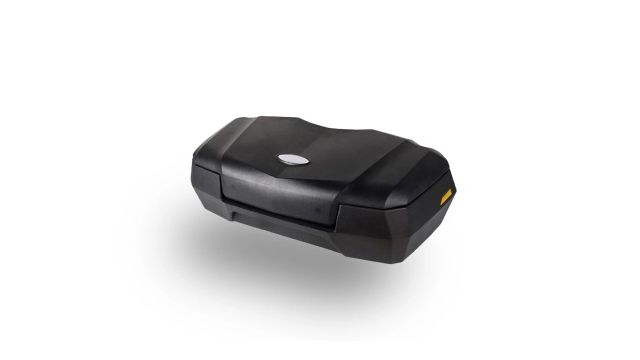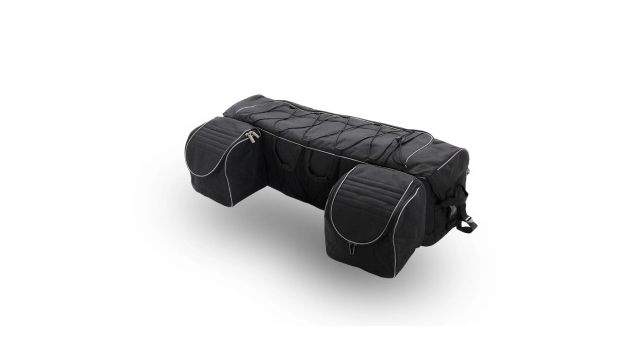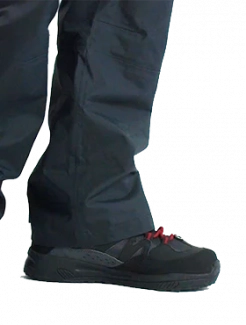Don't even think about riding without these things
Difficult routes are always quite unsafe, so we recommend going with company. And if you dare to ride off-road by yourself — here's a list of everything you need.
Which case is "the right one"
Let's choose a case, then we will pack all the items in it.
Choose a case so that it is as durable and strong as possible, dirtproof/mudproof and waterproof, with tight latches, otherwise if it opens up on a bump — things won’t be fun.
The most stylish
Such cases look, of course, cool, no doubt — an aggressive and predatory look, everyone is in admiration, the girls sigh… But such a design may be less practical.
You are going to smash a clay mess, after which washing such a trunk is as unbearable as possible.
Look how many cavities there are — you will have to pick out the dirt from each one, otherwise over time it will be all inside the case.
Conclusion: the fewer ribbed elements there are on the case — the more convenience and neatness.
The most discreet
Looks restrained and strict, like a classic suit compared to a biker jacket.
Smooth, not ribbed, not oversaturated with convex elements. After riding on this, there is less dirt and it is much easier and faster to wipe it off.
Conclusion: sleek trunks are more restrained in design and at the same time more practical.
The softest
A soft cloth bag is an old topic of discussion. Some praise them for their convenience, for others they are not reliable enough.
We will tell you a secret: don't listen to anyone — if it's convenient, use it, if it's not convenient — don't use it. Disputes are about taste.
Just remember that soft cloth cases are easier to tear and wet in harsh conditions. If you go on a ride in not very harsh conditions and not far from civilization — a fabric case may well be suitable.
Conclusion: cloth cases are best used not in harsh conditions.
The loudest
In these models, the speakers are built into the body, so if you want to arrange a bass-party while ploughing through dirt on your ATV — you need a case with speakers.
Another thing is that this is a controversial issue: how reasonable is it to use such cases on the off-road. We constantly crush the dirt, break up the clay, the water flies in all directions… All this can get into the speakers. At least on hard rides, this is very likely.
Conclusion: a case with built-in speakers can be suitable if you are not going on a hard ride, but simply on a quad-party.
Whichever case you choose, it does not give a 100% guarantee that water will not get into it. Therefore, pack all the necessary things and especially equipment in hermetic bags and hermetic covers — in Finntrail you will find everything you need to protect your belongings.
Choose hermetic backpacks, waterproof bags and phone pouch here.
How to prepare for the ride
Choosing your outfit is not as difficult as it seems. Over the past 30-40 years, the industry has amassed thousands of facts about how to make the right gear — you just have to read about them. If you are lazy or there is no time — we have selected sets for you, with which you can go to the mud in any conditions.
We also wear such kits ourselves, therefore we guarantee maximum comfort and protection in a mud fight.
What to put in the case for riding

We figured out which case to choose, now we will decide what to take with us. Let's start with something small to warm up.
- wet wipes and paper towels — often you have to wipe something: hands, a mask, or something else
- rags or pieces of cloth — you can wipe something or place them between objects so that they do not jingle or rattle while driving
- medical gloves — if you have to poke around in oil or fuel oil, gloves will help
- thick gloves — take a spare pair, or even two, that would be better.
Let's go further.
A heat tablet or other similar fuel, lighter fluid, matches, a pair of lighters. These things will even light raw firewood and will help, for example, prepare a magnificent dinner in the bosom of nature in almost any conditions.
Cutting or chopping tool. An ax and a saw will do just fine, or a machete if you want a real helper against branches and twigs! If you or someone from your group gets caught on a tree, it will be easy to chop off an impudent branch with a hatchet. Don't skimp — choose a cleaver that you don't have to sharpen after each bush.
And now that we have assembled everything, the most important part! A spare CVT belt — you have to remember this by heart like the alphabet.
There are riders who rely on their experience and think that this will never happen to them, but when the belt breaks during the ride, it's real hell. So, it's better to always carry a spare one with you, it won't take much space, and it will save you a million nerves. If you have a BRP, you also need an M8 bolt 55 mm in length — without it, you will not be able to replace the belt.
Spare winch may come in handy. If you rip out or damage the main one, the spare will help pull the car out. The same with the cable: it is worth taking a spare one in case the main one rips.

Bungee cord is a good elastic cord that comes in very handy if you need to attach something to the ATV body.
Insect spray or repellent, depending on the season. In winter, you probably won't need it. A couple of rolls of good adhesive tape. Aluminum tape is a very good thing, it is heat-resistant and very sticky.
Most importantly: pink duct tape! When someone breaks, it's always fun to make things worse and give the person some pink duct tape. The pinker the better.
What tools and parts to take with you

At any time, you can lose a bolt, break a headlight, rip threads or puncture a tire… As we all know, a real hardcore ride can really wear your vehicle, so you should always carry your tools with you:
- socket wrenches, tubular, articulated, etc.
- adjustable wrenches
- ratchets and extensions to them
- wrenches specific to your quad model
- snap ring pliers
- screwdrivers with nozzles
- crank with inserts
- wire cutters
- jackknife
It’s better to have an extra wrench, than not enough people for a ride, so do not hesitate about tools — all the more you shouldn't carry them on your back.
There are at first glance nondescript details that are often forgotten, but which are very helpful:
- clamps, ties are a must-have, they can pull off anything
- wire — not as life-saving as clamps, but also a very useful thing
- self-tapping screws — very helpful when you need to, for example, quickly make a butt joint
- washers, nuts, hex heads, small and large gaskets — all this can help out at the most unexpected moment. Well, for example, I repaired a caliper or something like that, I lost a bolt, and you have spare bolts right there in the box
- paracord — there are legends that this is an invention of an extraterrestrial civilization. The thing is amazing, you can unravel it and get a bunch of the same small laces. They can bind anything. If you haven't heard about it, there are special "survival bracelets" made of paracord — woven so that they can be easily and quickly disbanded in an emergency
Stock up on such little things. Keep all of them close, but not in a common bunch: start a small box with compartments, better waterproof.
Repair kit for tubeless tires with strips, harnesses and tire sealant. If someone or you get a couple of small punctures, it will help you hold out.
Additionally, it is worth stocking up on some "chemistry":
- high-temperature silicone or material for making patches and gaskets: universal patches, flagella, plasters, fungi
- cold welding kit like J-B Weld or similar
- two-component epoxy resin
- Super glue
WD-40, of course, you can’t go anywhere without it. WD-40 in mud is like drinking water in the desert. To clean a part, remove dirt, especially if you cannot get close with the wrench — WD will always help out.
Antifreeze bottle. Useful if you overheat. A portable compressor to inflate the tires in case of something, especially if you are stuck after a puncture. Fuses and kit for troubleshooting wiring problems. Several small adapters, starting-charger. If you have beadlocks, you probably know how often the tightening is loosened, so it's worth bringing a set of spare lock bolts and washers with you.
Remember, this is very important

Find out which node on your ATV is the weakest, and always bring replacement parts for that node with you. Of course, it will be inconvenient to carry the entire suspension with you… but it is better to keep some non-bulky parts in a secluded corner of the trunk.
What to put in a travel first aid kit

Being able to patch up your vehicle in time is good. Being able to patch yourself up in time is a vital issue. During riding, anything can happen. A first aid kit should always be with you, especially if you are alone on the off-road.
Liquids, tablets, powders, potions and other medicines, which are always best carried in the first aid kit:
- hydrogen peroxide solution
- brilliant green and iodine
- ammonium chloride
- antiseptic
- something against headaches
- something against diarrhea
- sedative
- emetics and antiemetics
- antiallergic drugs
- sterile bandages, regular, elastic
- bactericidal plasters and in rolls
- cotton wool and cotton pads
- q-tips
- liquid patch
- gauze bandages
- non-stick dressings
- sterile strips
This is a list of medical supplies you should definitely put in your medicine cabinet, but it's not final — you can always bring something else.
Food, water, GPS and more

Taking care of your ATV is important, but don't forget about yourself. Be sure to take with you some food and some other things that will help in case of something:
- GPS navigator — do not rely on your smartphone alone, ordinary phone maps do not always contain all routes.
- Drinking water, chocolate or protein bars — you can refresh yourself if you have to wait a long time for help.
- Removable thermal underwear — there will be something to change into if something goes wrong.
- Diode headlamp — it is convenient to light it up in the dark or when you need to get close to hard-to-reach parts of the quad.
- Canister with gasoline — you can refill the tank, especially if you are driving far from civilization.
This small list will help you bring your essentials for emergencies, but you can always add your own.
Riding alone: the result

Let's summarize. Here's a quick checklist of everything that's listed in the article:
- case
- wet wipes, rags, medical gloves
- thick gloves
- warm gloves
- theme blanket
- liquids for ignition, lighters, matches
- ax or saw
- spare CVT belt
- spare winch, rope, cord
- insect spray, repellent
- tape
- pink tape
- set of different tools
- jackknife
- hardware, clamps, ties, wire
- paracord
- kit for repairing tubeless tires, chemicals
- WD-40
- antifreeze bottle
- portable compressor
- wiring troubleshooting kit
- spare parts for the most problematic unit specifically for your ATV
- first aid kit
- food, water, GPS-navigator and more
The tools, parts and medical supplies that we have listed are a standard set. The list turned out to be long, but in fact, these are all important items. It is worth taking, if not all, then most of it — for group trips too. You always have to be ready to help and take care of someone from your gang — this is the true spirit of ATV unity.







